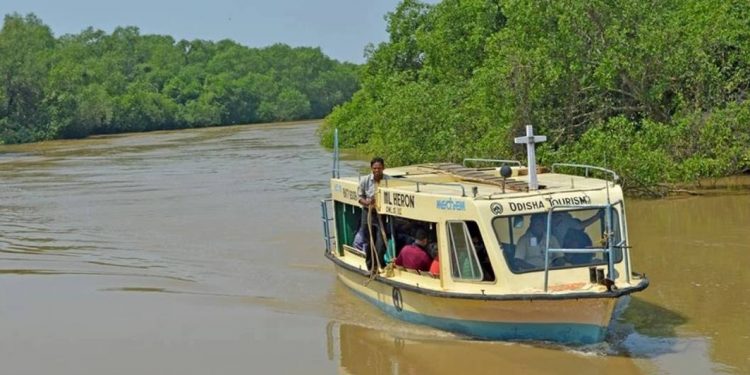Kendrapara: The Bhitarkanika Wildlife Sanctuary under Rajnagar block in this district spread over 672 sqkm is fast losing its cover due to various reasons and being pushed into the vicious circle of pollution, a report said.
If this trend continues, the sanctuary might lose its national park status. This will seriously hit the tourism industry in the district. The Bhitarkanika National Park is one of the wonders in the world known for its rich biological diversity.
The colourful birds, rare sea turtles and saltwater crocodiles and a variety of other wildlife animals inhabit this eco-system which is one of Asia’s most spectacular wildlife sanctuaries.
These are a real feast to the eyes of tourists and a subject of importance for the researchers. The large stretch of mangrove forests and medicinal plants attracts the nature lovers.
The Bhitarkanika is situated on the delta created by the Brahmani, Baitarani and Dhamra sea mouths. It is known for its natural environment, landscape, biological diversity and 62 types of mangrove forests and 215 types of wildlife.
UNESCO made an attempt to place Bhitarkanika in World Heritage Site in 2016. The UNESCO conducted a survey but Bhitarkanika missed the World Heritage Site tag as the mangrove eco-system was found wanting on several counts.
It was reported that much of the land within Bhitarkanika Wildlife Sanctuary is privately owned by local community of Bangaldesh refugees. Moreover, there are other areas where the tenure of the land is currently under dispute.
It was noted that human impacts from communities situated within Bhitarkanika are extremely high as land use in this area is predominantly agricultural including livestock grazing, shrimp cultivation and construction of houses within the sanctuary by destroying the mangrove forests.
The Central Groundwater Board conducted a groundwater study in 2011. It found excess presence of harmful chemicals like nitrate, iron and fluorides in the groundwater which is likely to destroy the bio-diversity of the sanctuary. The board advised the state government to recharge groundwater through construction of artificial dams in the rivers and other water bodies.
Later, a team of researchers comprising BC Behera from North Odisha University in Baripada, RR Mishra from MITS School of Biotechnology, HN Thatoi from College of Engineering and Technology in Bhubaneswar, SK Dutta from IIS in Bangalore, KK Patra of NITS in Rourkela conducted a survey of the Mahandi delta region and the Bhitarkanika sanctuary in 2014. They submitted a report which has become a cause of concern for the residents and nature lovers.
The total dissolved solids (TDS) as well as harmful chemicals like chloride, phosphate and magnesium have increased in the water. This has happened because of lack of management of industrial and urban wastes.
The team examined the water of Hansua river at Jambu, the water in the mangrove forest in Kharinasi, the waste water of the prawn firms at Triveni and Nuagada as well as the discharged waste water of IFFCO and PPL fertilizers plant in the Mahanadi river.
Their report claimed that there is a presence of 4389 mg to 12,575 mg of chloride in the drinking water in the area which is higher than the permissible limits of 250 mg.
This apart, phosphate content in the water has increased a lot while nitrate is at a standard level and calcium content is increasing due to discharge of industrial wastes. They warned that an increase in the chemical contents will pose a serious threat to the existence of mangrove forests, saltwater crocodiles and birds in the sanctuary.
PNN






































